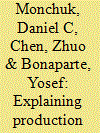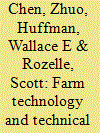|
|
|
Sort Order |
|
|
|
Items / Page
|
|
|
|
|
|
|
| Srl | Item |
| 1 |
ID:
078029


|
|
|
|
|
| Publication |
2007.
|
| Summary/Abstract |
A concentration index methodology to analyze the inequality in childhood malnutrition in China is outlined. Height-for-age z-score is used as a measure of childhood malnutrition. Using household survey data from nine Chinese provinces, we found that per capita household income, household head's education, urban residence and access to a bus stop are associated with lower malnutrition. Child's age has a nonlinear relationship with the malnutrition status. Income growth and access to public transportation are associated with less severe inequality, while rural-urban gap, provincial differentials, and unequal distribution of household head's education are associated with higher levels of inequality in childhood malnutrition. Gender is not relevant for either malnutrition status or inequality. Investments in infrastructure and welfare programs are recommended to ameliorate the inequality in childhood malnutrition
|
|
|
|
|
|
|
|
|
|
|
|
|
|
|
|
| 2 |
ID:
095937


|
|
|
|
|
| Publication |
2010.
|
| Summary/Abstract |
In this paper we examine more closely the factors associated with production inefficiency in China's agriculture. The approach we take involves a two-stage process where output efficiency scores are first estimated using data envelopment analysis, and then in the second stage, variation in the resulting efficiency scores is explained using a truncated regression model with inference based on a semi-parametric bootstrap routine. Among the results we find that a heavy industrial presence is associated with reduced agricultural production efficiency and may be an indication that externalities from the industrial process, such as air and ground water pollution, affect agricultural production. We also find evidence that counties with a large percentage of the rural labor force engaged in agriculture tend to be less efficient, and suggests that nurturing and promoting growth of non-primary agriculture may lead to more efficient use of labor resources in agriculture.
|
|
|
|
|
|
|
|
|
|
|
|
|
|
|
|
| 3 |
ID:
089550


|
|
|
|
|
| Publication |
2009.
|
| Summary/Abstract |
In this paper we fit stochastic frontier production functions to data of Chinese farms grouped into each of four regions-North, Northeast, East, and Southwest-over 1995-1999. These frontier production functions are shown to have statistically different structures, and the elasticities provide some evidence of diminished marginal products of chemical inputs in the East and capital services in the North and Southwest. Labor has a low elasticity except in the North. Standardized technical efficiency scores are estimated for the farms and are shown to have the same structure across regions and to be related to the age of the household head, land fragmentation, and the village migration ratio, controlling for year effects and village or regional fixed effects.
|
|
|
|
|
|
|
|
|
|
|
|
|
|
|
|
| 4 |
ID:
192343


|
|
|
|
|
| Summary/Abstract |
The inefficient use of healthcare resources is a persisting challenge to almost all healthcare systems, making it imperative to understand the underlying factors of healthcare demand. This paper investigates patients' health-seeking behavior in rural China using a random coefficients logit model. We further perform a counterfactual simulation and welfare analyses to evaluate the inefficiencies in health services utilization. The counterfactual simulation reallocates patients to more efficient health providers following the principles of the hierarchical medical system. Our analysis suggests that out-of-pocket expenses and distance to providers discourage patients from utilizing healthcare, while quality of care has a positive effect on patients' hospital choices. However, significant heterogeneity exists in patient preferences over quality of care, out-of-pocket expenses, and distance to providers. The simulation results show that the overall welfare change may have masked variations related to the hypothetical change, with societal welfare loss from switching to higher-tier providers. Our analysis provides support for policies to improve hospitals and assist rural patients in financing healthcare in China.
|
|
|
|
|
|
|
|
|
|
|
|
|
|
|
|
|
|
|
|
|